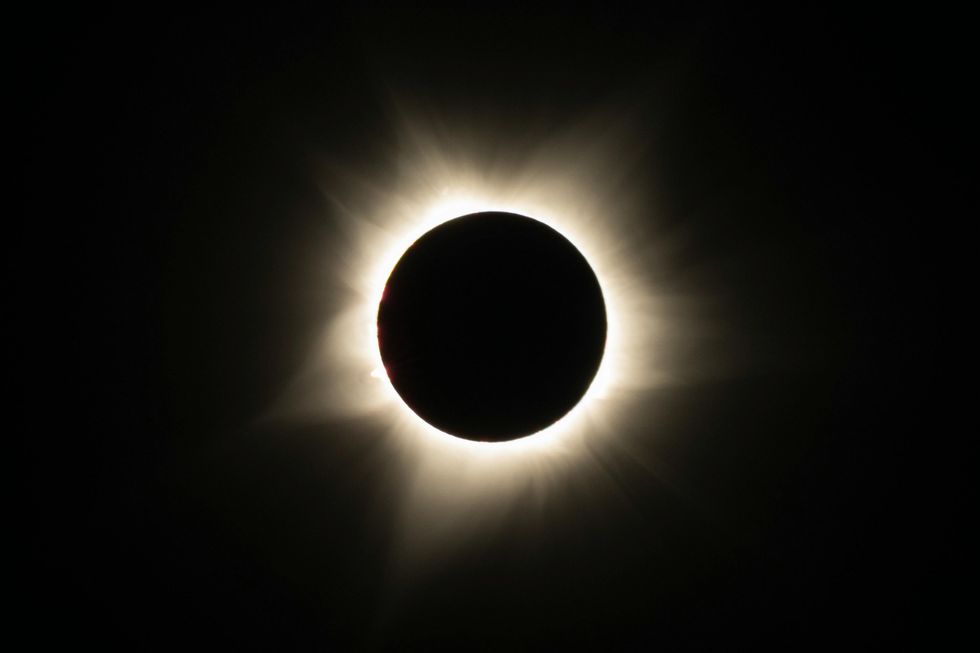Harriet Brewis
Apr 08, 2024
Top 10 Weirdest Things to Happen during a Total Solar Eclipse
WatchMojo / VideoElephant
Millions of people across a swath of North America are bracing themselves to stare up at the heavens.
They will be treated “weather permitting” to a total solar eclipse on Monday (8 April), with the Moon set to block the sun completely for more than four minutes in some regions.
The exact time of the eclipse will vary by state and time zone, and its visibility is, inevitably, at the hands of the skies with forecasts looking dispiritingly cloudy.
The eclipse’s path will run along a path starting in Mexico, then crossing through the US and into Canada.
Enthusiasts have already begun gathering in places along the "path of totality", with the celestial spectacle set to begin in Mexico at around 11.07am local time (7pm UK time).
It is the first time in seven years a solar eclipse will pass through North America, with the next one not due in the US until August 23, 2044, according to NASA.
At up to 4 minutes and 28 seconds, this one will last longer than the total eclipse of 2017, which clocked in at up to two minutes and 42 seconds.

Now, given that some 32 million people in the US live within the path of totality, with another five million predicted to travel there, countless prospective observers want to know: is it safe?
Of course, humans have marvelled at eclipses since the dawn of time, leading to the forging of endless theories and myths.
And whilst our scientific understanding of the process has grown exponentially, some fears surrounding the effects of total eclipses persist.
Fortunately, NASA has debunked many of these fallacies on its website, starting with the potency of the radiation emitted during the process.
The agency explains that despite what we’re often told, peering up at an eclipse cannot blind you.
“During a total solar eclipse when the disk of the moon fully covers the sun, the brilliant corona emits only electromagnetic radiation, though sometimes with a greenish hue,” it says.
“Being a million times fainter than the light from the sun itself, there is nothing in the coronal light that could cross 150 million kilometres of space, penetrate our dense atmosphere, and cause blindness.”
However, it concedes: “If you watched the sun before totality, you will catch a glimpse of the brilliant solar surface and this can cause retinal damage, though the typical human instinctual response is to quickly look away before any severe damage has actually occurred.”
In a similar vein, many people believe that, if you’re pregnant, watching an eclipse could harm your baby.
Again, NASA stresses, this is false, noting that this myth is “related to the previous false idea that harmful radiations are emitted during a total solar eclipse”.
It goes on: “Although the electromagnetic radiation from the corona, seen as light, is perfectly safe, there is another form of radiation that travels to Earth from the sun.
“Deep in the solar interior where nuclear fusion takes place to light the sun, particles called neutrinos are born, and zip unimpeded out of the sun and into space. They also pass through the solid body of the moon during the eclipse and a second or so later reach Earth and pass through it too.
“Every second, your body is pelted by trillions of these neutrinos no matter if the sun is above or below the horizon. The only consequence is that every few minutes a few atoms in your body are transmuted into a different isotope by absorbing a neutrino. This is an entirely harmless effect and would not harm you, or if you are pregnant, the developing fetus.”
Despite all these assurances, experts still advise eclipse viewers to use protective solar glasses to prevent eye damage from looking at the sun with the naked eye.
Only during the few minutes of totality can the sun be safely viewed without such glasses, they say.
Seasoned eclipse viewers have described the 15 minutes before totality as foreboding, with shadows becoming oddly crisp and sunshine assuming an eerie quality.
In the seconds before totality, a phenomenon called "shadow bands" may appear - shimmering shadows on the ground, like those seen on the bottom of a swimming pool.
The last remaining bit of brilliant sunlight before totality creates a "diamond ring effect" in which a single bright spot appears along the lunar edge even as the sun's atmosphere leaves a ring of light around the moon.
This will be the ninth total eclipse for Anthony Aveni, author of the book ‘In the Shadow of the Moon: The Science, Magic and Mystery of Solar Eclipses’ and a professor emeritus of physics and astronomy, sociology and anthropology at Colgate University in Hamilton, New York.
Speaking to the news agency Reuters, Aveni said each eclipse he has witnessed has inspired deep awe in everyone around him who saw it, igniting a sense of community. He added that people frequently burst into tears and hug complete strangers.
"No matter who you are or when you lived, the sight of an eclipse begins with fear," he said. "The imagery shocks you. That fear is gradually transformed into awe and then into a sublime state."
Sign up for our free indy100 weekly newsletter
How to join the indy100's free WhatsApp channel
Have your say in our news democracy. Click the upvote icon at the top of the page to help raise this article through the indy100 rankings
Top 100
The Conversation (0)













